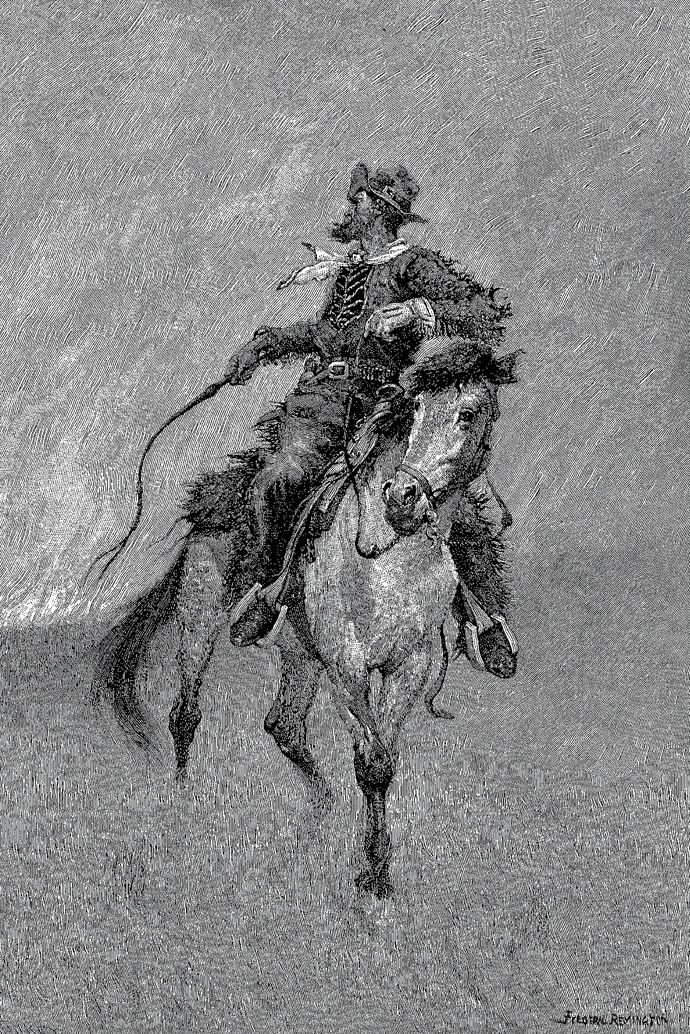I have known cowboys broken in body and twisted in spirit, bruised by debt, failure, loneliness, disease, and most of the other afflictions of man, but I have seldom known one who did not consider himself phenomenally blessed to have been a cowboy, or one who could not cancel half the miseries of existence by dwelling on the horses he had ridden, the comrades he had ridden them with, and the manly times he had had.
To be a cowboy meant, first of all, to be a horseman. J. Frank Dobie was quite right when he pointed out that the seat of the cowboy’s manhood is the saddle. I imagine, too, that he understood the consequences of that fact for most cowboys and their women, but if so he was too kindly a man to spell that out in his books. I would not wish to make the point crudely, but I do find it possible to doubt that I have ever known a cowboy who liked women as well as he liked horses, and I know that I have never known a cowboy who was as comfortable in the company of women as he was in the company of his fellow cowboys.
This is not, I think, the result of repressed homosexuality, but of repressed heterosexuality, complicated by a commitment to a heroic concept of life that simply takes little account of women. Certainly the myth of the cowboy is an efficacious myth, one based first of all upon a deep response to nature. Riding out at sunup with a group of cowboys, I have often felt its power. The horses pick their fresh ways delicately through the dewy country, the brightness of sunrise has not yet fallen from the air, the sky is blue and all-covering, and the cowboys are full of jokes and morning ribaldries. It is a fine action, compelling in itself and suggestive beyond itself of other centuries and other horsemen who have ridden the earth.
Unfortunately, the social structure of which that action is a part began to collapse almost a hundred years ago, and the day of the cowboy is now well into its evening. Commitment to the myth today carries with it a terrible emotional price.

An illustration by Frederic Remington, which appeared in the July 1891 issue of Harper’s Magazine
If the cowboy is in any sense a tragic figure, one element of the tragedy is that he is committed to an orientation that includes but does not recognize the female, which produces, in day-to-day life, an extraordinary range of frustrations. Curiously, the form the cowboy’s recognition does take is literary: he handles women through a romantic convention. The view is often proffered by worshippers of the cowboy that he is a realist of the first order, but that view is an extravagant and imperceptive fiction. Cowboys are romantics, extreme romantics, and ninety-nine out of a hundred of them are sentimental to the core. They are oriented toward the past and face the present only under duress, and then with extreme reluctance.
People who think cowboys are realists generally think so because the cowboy’s speech is salty and apparently straightforward, replete with the wisdom of natural men. What that generally means is that cowboy talk sounds shrewd and perceptive, and so it may be. In fact, however, both the effect and the intention of much cowboy talk is literary: cowboys are devoted aphorists. Some are brilliant aphorists, from whom one is proud to steal, but usually their phrasing is worth more than their perception. Their insights are either wildly romantic, mockcynical, or solemnly sentimental. The average cowboy is an excellent judge of horseflesh, only a fair judge of men, and a terrible judge of women, particularly “good women.” Most of them marry, and love their wives sincerely, but since their sociology idealizes women and their mythology excludes them, the impasse that results is often little short of tragic. Now, as then, the cowboy escapes to the horse, the range, the work, and the company of comrades, most of whom are in the same acknowledged fix.
From “Take My Saddle from the Wall,” which appeared in the September 1968 issue of Harper’s Magazine.






































































































